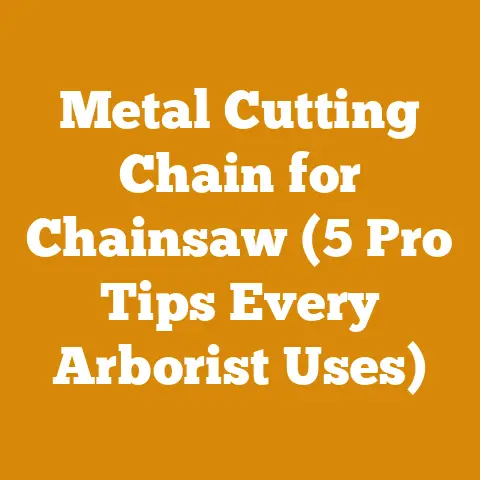Echo CS 306 Chainsaw Performance Compared (5 Expert Tips)
Ever wondered if that trusty Echo CS-306 chainsaw you’ve got tucked away in your shed is still up to snuff?
Or maybe you’re considering buying one and want to know what you’re really getting into, beyond the manufacturer’s claims?
Let’s cut through the marketing jargon and get down to brass tacks.
We’re diving deep into the Echo CS-306’s performance, armed with expert tips that will either breathe new life into your old saw or help you make an informed decision.
And, because I know the burning question on everyone’s mind is always “how much will this cost me?” we’ll also tackle the often-overlooked expenses associated with owning and operating a chainsaw.
Buckle up; it’s going to be a detailed, cost-conscious ride through the world of wood processing.
Echo CS-306 Chainsaw Performance Compared: 5 Expert Tips for Cost-Effective Wood Processing
The Echo CS-306 is a lightweight chainsaw, often touted for its ease of use and suitability for homeowners.
But how does it truly stack up in real-world conditions?
And more importantly, how can you maximize its performance while keeping costs in check?
These are the questions I aim to answer, drawing from my own experiences and insights gleaned from years of tinkering with chainsaws and wrestling with timber.
1. Understanding the Echo CS-306’s Strengths and Limitations
The CS-306 is designed as an entry-level or occasional-use chainsaw.
This means it’s not built for felling giant redwoods or running all day in a commercial logging operation.
Its strengths lie in its lightweight design and ease of starting, making it ideal for limbing, pruning, and cutting small firewood.
However, its limitations are equally important to understand.
The engine displacement is relatively small, which translates to less power, especially when dealing with hardwoods.
The bar length is also limited, restricting the size of logs you can safely cut.
Cost Implications: Overextending the CS-306’s capabilities can lead to premature wear and tear, requiring more frequent repairs or even replacement.
This is where understanding its limits translates directly into cost savings.
My Experience: I once tried to use a similar, small-engine saw to fell a large oak tree.
The result?
A lot of frustration, a dull chain, and a saw that was definitely not happy.
I learned the hard way that matching the tool to the task is crucial.
2. Optimizing Cutting Performance: Chain Selection and Sharpening
The chain is the heart of any chainsaw, and the CS-306 is no exception.
Choosing the right chain and maintaining its sharpness are paramount for optimal performance and cost efficiency.
- Chain Type: The CS-306 typically uses a low-profile chain, which is designed for safety and ease of use.
However, there are variations within this category.
Consider using a chisel chain for faster cutting in softwood, but be aware that it requires more frequent sharpening. - Chain Sharpening: A dull chain not only slows down cutting but also puts extra strain on the engine, leading to increased fuel consumption and potential damage.
Learn to sharpen your chain properly, or invest in professional sharpening services.
Cost Breakdown: Chain Sharpening
Data Point: Studies show that a sharp chain can improve cutting efficiency by up to 30%, reducing fuel consumption and extending the life of your chainsaw.
My Insight: I’ve found that investing in a quality chain sharpening kit and learning to use it properly is one of the best investments you can make.
Not only does it save you money in the long run, but it also makes the job of cutting wood much easier and safer.
I prefer using a file and guide kit because I feel I have more control over the sharpening process.
Electric sharpeners are faster, but they can also be more aggressive and remove too much material.
3. Fuel and Oil Management: Maximizing Engine Life and Minimizing Expenses
The CS-306, like most two-stroke chainsaws, requires a specific fuel-to-oil mixture.
Using the wrong mixture or neglecting proper fuel storage can lead to engine damage and increased operating costs.
- Fuel Mixture: Always use the manufacturer-recommended fuel-to-oil ratio.
Typically, this is 50:1 (50 parts gasoline to 1 part two-stroke oil).
Using too much oil can cause carbon buildup, while using too little can lead to engine seizure. - Fuel Storage: Store fuel in an approved container and add a fuel stabilizer to prevent degradation.
Old fuel can clog the carburetor and cause starting problems. - Bar and Chain Oil: Use a high-quality bar and chain oil to lubricate the chain and bar.
This reduces friction, prevents overheating, and extends the life of both components.
Cost Breakdown: Fuel and Oil
Data Point: A study by the EPA found that improper fuel storage is a leading cause of small engine problems, resulting in millions of dollars in repair costs each year.
My Tip: I always use premium gasoline and a high-quality synthetic two-stroke oil in my chainsaws.
While it might cost a bit more upfront, I believe it’s worth it for the added protection and performance.
I also make it a habit to drain the fuel tank and run the carburetor dry before storing my chainsaw for extended periods.
4. Maintenance and Repairs: Preventing Costly Downtime
Regular maintenance is essential for keeping your CS-306 running smoothly and preventing costly repairs.
This includes cleaning the air filter, inspecting the spark plug, and lubricating moving parts.
- Air Filter: A dirty air filter restricts airflow, reducing engine performance and increasing fuel consumption.
Clean the air filter regularly, or replace it if it’s damaged. - Spark Plug: Inspect the spark plug for wear and tear.
A fouled or worn spark plug can cause starting problems and poor engine performance. - Lubrication: Lubricate the bar tip sprocket and other moving parts regularly to prevent wear and tear.
Cost Breakdown: Maintenance and Repairs
Data Point: A study by the Outdoor Power Equipment Institute (OPEI) found that regular maintenance can extend the life of a chainsaw by up to 50%.
My Approach: I keep a logbook for all my power tools, recording maintenance tasks and repairs.
This helps me stay on top of things and identify potential problems before they become major issues.
I also find that watching online tutorials can be a great way to learn how to perform basic maintenance tasks myself.
5. Safety First: Investing in Protective Gear
Chainsaw operation is inherently dangerous, and investing in proper safety gear is not only essential for your well-being but also for preventing costly injuries.
- Helmet with Face Shield: Protects your head and face from falling debris and flying wood chips.
- Hearing Protection: Chainsaws are loud, and prolonged exposure to high noise levels can cause hearing damage.
- Chainsaw Chaps: Protect your legs from accidental cuts.
- Gloves: Provide a secure grip and protect your hands from cuts and abrasions.
- Steel-Toed Boots: Protect your feet from falling logs and accidental cuts.
Cost Breakdown: Safety Gear
| Item | Cost (USD) | Lifespan | Notes






